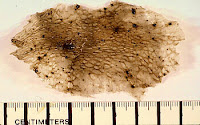 Limu o Pele is a magical product of the volcano, formed when waves wash over lava flowing into the sea.
Limu o Pele is a magical product of the volcano, formed when waves wash over lava flowing into the sea. (Photo: Limu o Pele fragment. USGS photo by J.D. Griggs.)
It is being created daily when Kīlauea's lavas ooze into the ocean.
Seawater gets trapped under molten rock. The water flashes to steam. The still-molten rock forms a huge, thin bubble. Almost instantly, the bubble wall hardens, the bubble explodes and and the tissue-thin fragments waft away on the wind.
If there's an onshore breeze, you can find it in greenish-brown see-through flakes of volcanic glass.
When I first saw it, the tiny flakes had filled voids in a lava flow and was gleaming gold in the setting sun. You could pick it up in your hand, and the fragments slid against each other.
It seems odd, but the stuff also forms deep under the sea, and is being studied at the volcano Loihi.
Loihi, sometimes called the “next Hawaiian island,” lies 20 miles off the southeast coast of the Big Island. Its tallest point is still 3,000 feet below the waves.
There, the water temperature is cold, and the water pressure is extremely high. But the power of steam is enormous, and the presence of the volcanic glass flakes proves that the undersea eruptions create similar processes to those along the shore.
Still the Loihi limu o Pele is not identical to the stuff at the surface.
“Limu o Pele fragments quench at fantastic rates and that affects the structure of the glass,” said David Clague, formerly with the Hawaiian Volcano Observatory and now at the Monterey Bay Aquarium Research Institute.
A report on the Loihi volcanic glass was published in the journal Earth and Planetary Science Letters by researchers Marcel Potuzak, Alexander Nichols and Donald Dingwell of the University of Munich's Earth and Environment program, and Clague. Potuzak is also association with Corning, Nichols with the Japan Agency for Marine Earth Science and Technology, and Dingwell with Stanford's Department of Geological and Environmental Sciences.
The article is entitled, “Hyperquenched volcanic glass from Loihi Seamount, Hawaii.”
The used the limu o Pele bubble wall fragments to study the super-fast cooling of the volcanic rock as it formed the volcanic glas bubbles—a process they called hyper-quenching.
The limu o Pele at Loihi appears to “have experienced the fastest cooling of any natural volcanic glass measured to date,” the authors write in their abstract.
When the basalt from Hawaiian volcanoes cools slowly, the rock normally tends to form crystals. But the crystal formation can be bypassed, the authors write, if the lava can be cooled superfast.
Limu o Pele is not crystalline, “thus, the mere existence of such glasses on the sea floor is one measure of their rapid cooling,” the authors write.
© 2008 Jan W. TenBruggencate